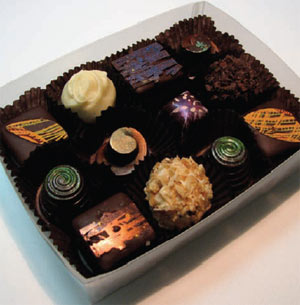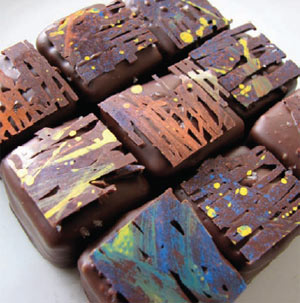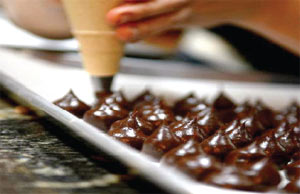 |
 |
 |
|
February 2012
|
A delectable feast for the sensesThe Cocoa Research Unit helps Isabel Brash to dream in chocolate
By Serah AchamOpen a box of Cocobel Chocolates and you face a delicious dilemma. Each hand-decorated morsel is such a work of art that it is as much a feast for the eyes as the palate. Pink and purple flowers, green and orange leaves, shimmery dust, toasted coconut flakes and even a bluish green fin adorn these confections. They’re the creations of Isabel Brash, architect gone chocolate. Isabel was working as an architect with Geoffrey Maclean in mid-2008 when she decided to try her hand at making chocolate. Work was slow and “I was always looking for projects to do,” she says. “Cocoa was one of the things that I started playing around with … I just wanted to try and make chocolate.” She did her research and got some cocoa from her brother’s estate at Rancho Quemado. “I didn’t even know they had cocoa,” she admits. Once she had her stock in hand, she wasted no time. “I started playing around with them and I just got hooked.” It’s akin to Alice’s plunge into the rabbit hole, she says. “It’s like falling into this thing that you never knew about before and as I kept researching I just became more and more enthralled with it.” And the deeper she fell into the hole, the more people jumped in with her; for that Christmas she found herself giving her chocolates to family members as presents. They gave her chocolates to their friends, who began asking if she could cater their events. While investigating opportunities to learn more about the art of chocolate making, “just for fun,” she discovered Ecole Chocolat, an online school which teaches chocolatiering as a business. She learnt about the history of chocolate, the history of the industry, the distinction between fine and commercial chocolate (Hershey’s for example), and who the leaders in fine chocolate are. “That course really opened me up to the whole industry and really got me thinking – ‘maybe I could do this as a little side business’.”
UWI’s Cocoa Research Unit (CRU) has been very helpful in the process, Isabel says. She first visited the CRU that year, after an invitation by the Friends of the Botanical Gardens. “They took us on a tour of the [International Cocoa] Genebank. I didn’t know anything about all that ... and I was fascinated to see all these trees from all over the world. That’s when I really got to know Prof [Pathmanathan] Umaharan and Darin Sukah and Naailah [Ali] and Frances Bekele,” Isabel says. A relationship developed and since then they are always available to answer her questions or send her useful information. “I always say they’re the heroes,” she declares. “In Trinidad, they’re the people who sincerely care about the industry.” In 2010, Isabel enrolled in Ecole Chocolat’s Master’s programme which took her to France and to the factory of her favourite chocolate maker, Michel Cluizel. “I love his chocolates more than any other fine chocolate I’ve ever tasted,” she says. “I love their company ethos, how they do business ... their business etiquette.” At Michel Cluizel, the chocolates are named after the estate which produces the beans, “so the estate gets recognition for the beans,” and the farmers are paid directly; another benefit to the estate. “I saw that they were doing a course with them and doing a tour of that factory … that was why I went.” It turned into the experience of a lifetime. She met Marc Cluizel (son of Michel) and found the courage to share a piece of her chocolate with him. He opened it in front of the class, “which I didn’t want him to do,” closed his eyes and tasted it. He was silent for a moment and then began listing the flavours he encountered, “bananas and vanilla and berries,” she remembers. He told her that it was, “very good chocolate, very good chocolate.” Her hand-made packaging reminded him of his grandmother’s hand-made paper wrapping for their company’s first set of chocolates. “That was the high point of everything. It’s like meeting a rock star... the ultimate.”
It’s a good thing since she has so much business now that it’s a challenge making enough chocolate to keep her customers satisfied. “People get really frustrated if they can’t get their chocolate today,” she says, but she won’t let that get in the way of the quality of her chocolates. “I’m not going to sell you something that’s halfway or just for the business. It’s by order and I do everything fresh.” She did so well for Christmas that “I’ve completely run out of my stock of chocolate,” so she started the year with a new batch. “Right now,” she says, “I’m roasting and shelling and grinding beans repeatedly,” and it’s the process of grinding that produces chocolate. Isabel explains that each cocoa bean consists of approximately 50 per cent fat, so when it’s ground, the beans become liquid. “I always say that’s when the cocoa jumbie sort of took over because you’re seeing this turning into liquid chocolate … and that you’re making chocolate and that’s really cool.” She grinds them into a semi-liquid which she then grinds with sugar depending on the type of chocolate she’s making. “I do a white chocolate, a milk chocolate and two different dark chocolates,” she explains. One of the dark chocolates is for her confections, which need to be firmer and so has a bit more cocoa butter than the other which is “a darker, richer chocolate,” for her plain dark chocolate bars. After leaving the chocolate in a refiner for “at least a couple days” to get her desired “quality, fineness and smoothness,” the chocolate is finished. “After I make the chocolate, I would put it in trays and let it harden and then use it when I need to make the other things.” At that point, she melts the hardened chocolate and tempers it “in order for the chocolate to look presentable.”
“Any kind of fruit that I use in the centres I also do myself,” Isabel specifies. Her sorrel, and honey passion fruit chocolates are made with real fruit. “It’s all fresh,” she says, “like the coconut. I buy the coconuts whole and shell and grate them.” She also uses mainly local flavours. “I do believe that we have such great fruits and great spices … it’s a pity that immediately people think of strawberries when they think of chocolate. But we have so many fun things that go so well with chocolate too, like guava and passion fruit.” Her recipes are “based on our local palate,” she says. Her sorrel chocolates have cloves in them, “because that’s how we make our sorrel.” She also makes a mango pepper flavoured chocolate, one with a cashew and coconut filling and, possibly the most intriguing, one filled with salt, pineapple and shadon beni. This one is called Mermaid’s Kiss, she says, because one bite evokes memories of a day at Maracas beach. Right now she makes her chocolates primarily by order since she uses fresh ingredients like cream and butter and fruits. However, when her shop is ready, “That’ll be a whole different thing. I’ll be making stuff all the time and people can just come in and buy.” Not to worry if you can’t wait that long. Her chocolates can be found at Malabar Farms. “They’re the only ones I distribute to at the moment. I’ve had a lot of requests but I’m very particular because of the temperature.” While other stores may turn their air conditioners off at night, at Malabar Farms, “they keep it on all the time. When you walk into that place it’s like walking into a fridge, so I trust it there.” She’s also very particular about placing expiration dates clearly on the packages so that consumers get them fresh. “It’s like your child you know?” Isabel says. “When you put so much work into it … I care about what people think when they buy it.” |


 Suggested by her father for its similarity to her own name, and approved by Isabel for its origins and meaning, Cocobel was established in the middle of 2009. “I didn’t want to name it after myself,” she says. “That’s just not me. I like to make a product that’s its own.” She really wanted a name that had a deeper meaning and was indigenous to Trinidad and Tobago, so she began to research “old cocoa gods … and I also went into Patois, because you know it’s such an indigenous thing for us.” As fate would have it, ‘Cocobel’ was exactly what she was looking for. During a fishing trip with his friends from Paramin who spoke Patois, her father asked their opinion on the name. “They said ‘oh that’s a great name! It means beautiful brown woman, or nice brown ting,” she relates. “So I was like ‘that’s perfect’ because it’s chocolate. It’s dark and brown and beautiful and I just wanted a name that meant something deeper … like dark beauty or earth beauty.” Once established, Cocobel “definitely took over,” she adds.
Suggested by her father for its similarity to her own name, and approved by Isabel for its origins and meaning, Cocobel was established in the middle of 2009. “I didn’t want to name it after myself,” she says. “That’s just not me. I like to make a product that’s its own.” She really wanted a name that had a deeper meaning and was indigenous to Trinidad and Tobago, so she began to research “old cocoa gods … and I also went into Patois, because you know it’s such an indigenous thing for us.” As fate would have it, ‘Cocobel’ was exactly what she was looking for. During a fishing trip with his friends from Paramin who spoke Patois, her father asked their opinion on the name. “They said ‘oh that’s a great name! It means beautiful brown woman, or nice brown ting,” she relates. “So I was like ‘that’s perfect’ because it’s chocolate. It’s dark and brown and beautiful and I just wanted a name that meant something deeper … like dark beauty or earth beauty.” Once established, Cocobel “definitely took over,” she adds.  The programme included a visit to the factory of another renowned name in fine chocolate, Barry Callebaut, as well as a workshop on what a day in the industry is like – creating recipes, working with people and using machinery for making truffles and bonbons. Since she had already begun to make her own chocolates, “going there helped my confidence a lot ... I started to do things a lot faster when I came back.”
The programme included a visit to the factory of another renowned name in fine chocolate, Barry Callebaut, as well as a workshop on what a day in the industry is like – creating recipes, working with people and using machinery for making truffles and bonbons. Since she had already begun to make her own chocolates, “going there helped my confidence a lot ... I started to do things a lot faster when I came back.” “I do things on different days,” she says, recounting her Christmas creations. “I had all these different flavours,” sorrel and ginger rum among them, “so I would take some days and just make the centres.” She’d cut them, put them aside and return the next day to coat them with the prepared chocolate.
“I do things on different days,” she says, recounting her Christmas creations. “I had all these different flavours,” sorrel and ginger rum among them, “so I would take some days and just make the centres.” She’d cut them, put them aside and return the next day to coat them with the prepared chocolate.